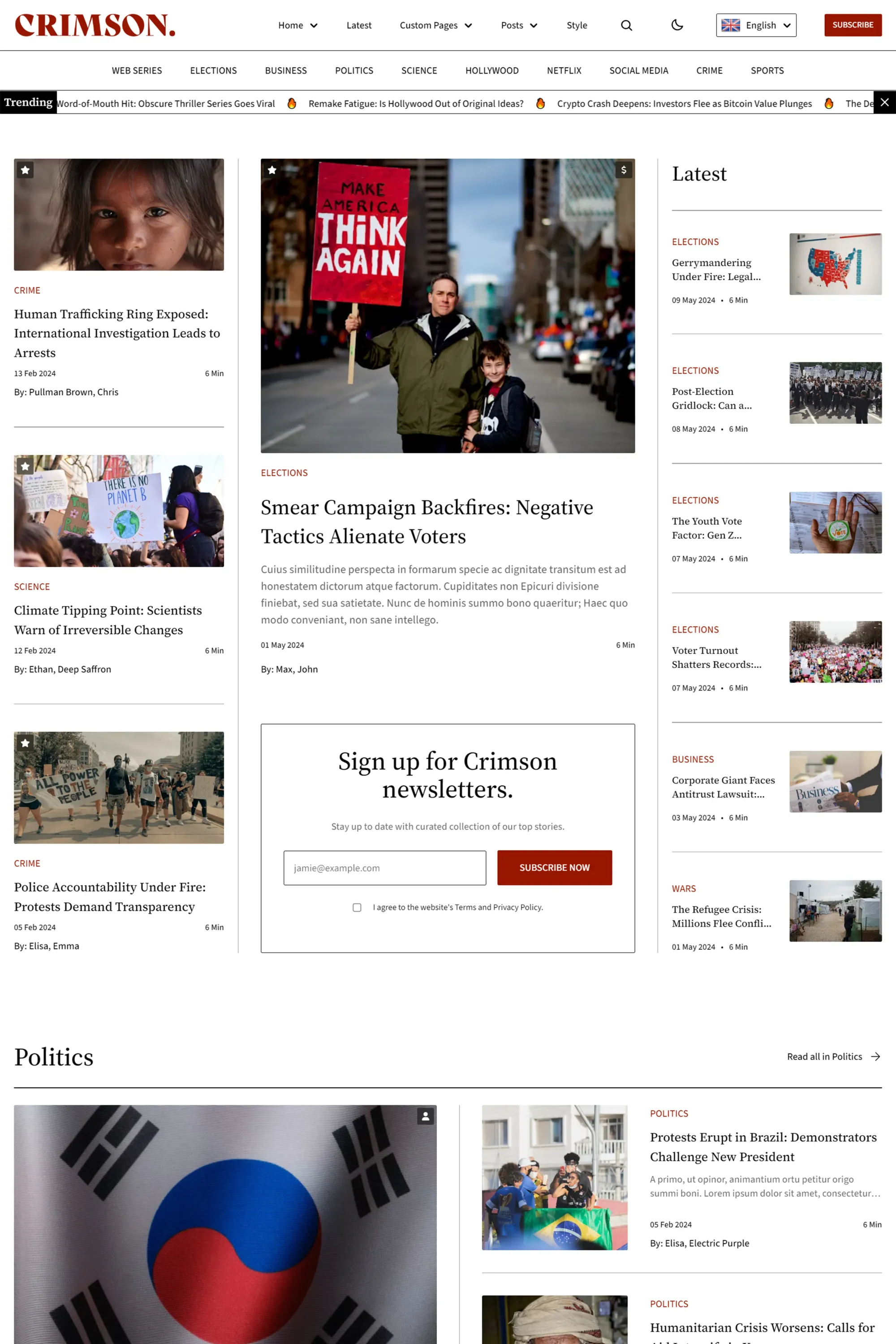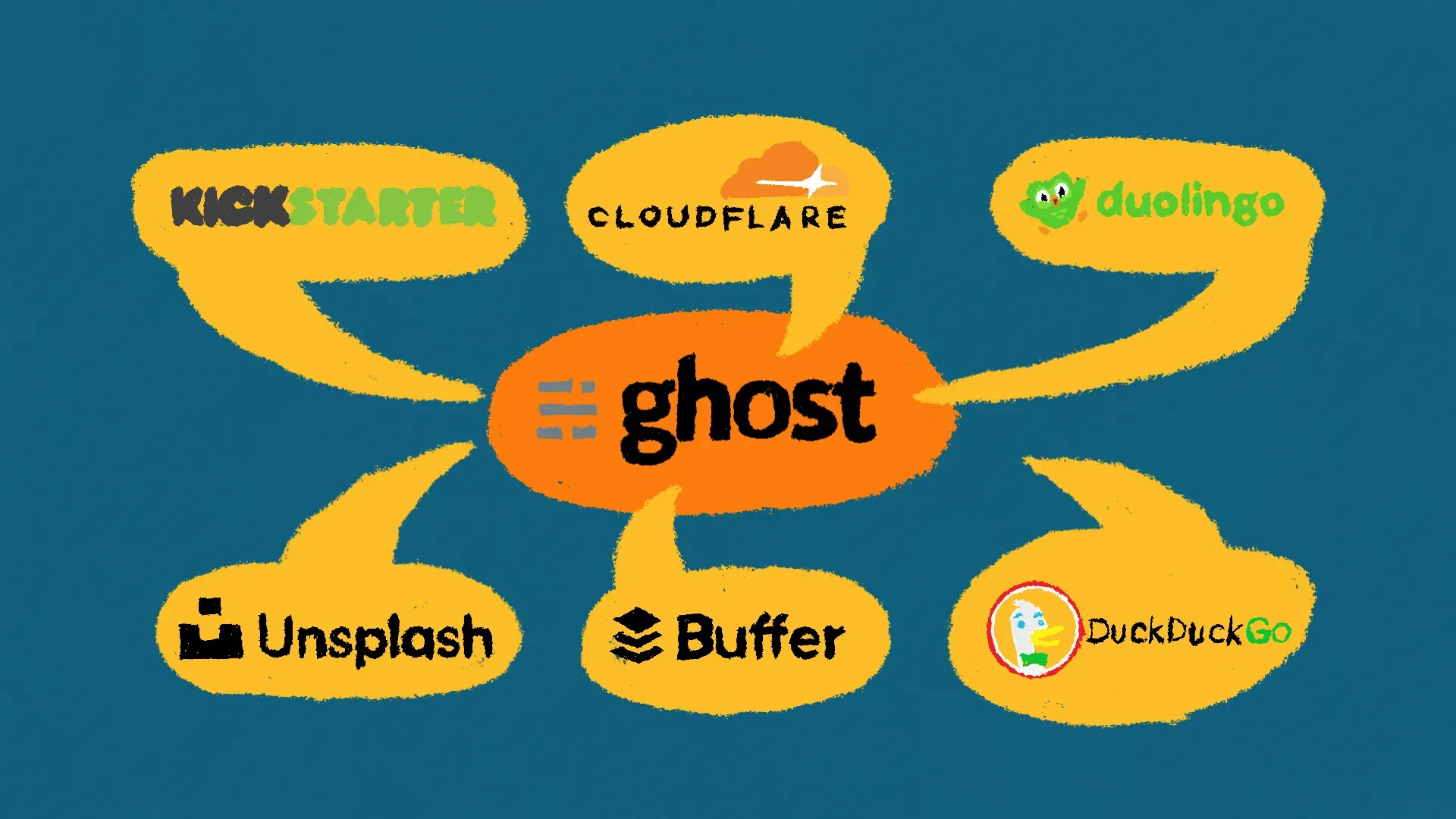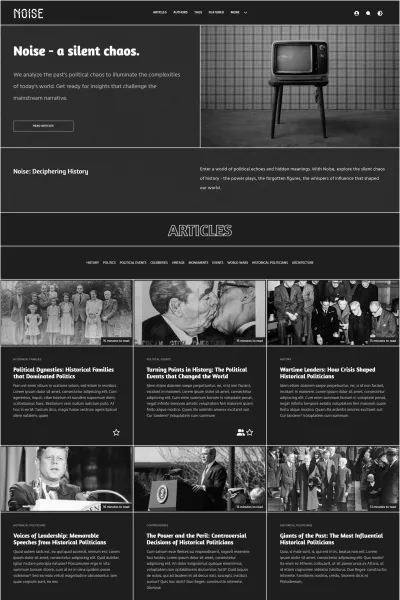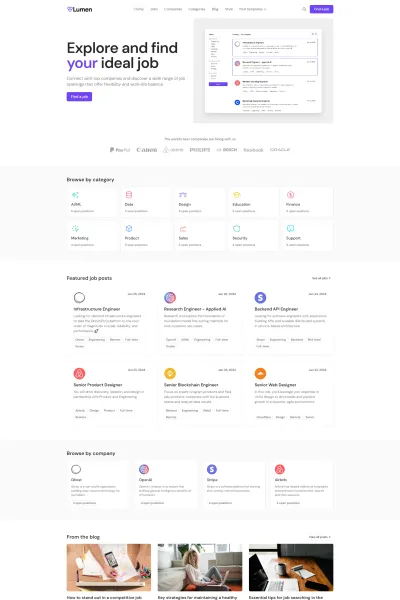In 2025, Ghost CMS has emerged as a preferred publishing platform for major brands like Buffer, DuckDuckGo, Duolingo, and Airtable. This in-depth article explores how these companies use Ghost to power high-performance blogs, manage newsletters, build communities, and share product updates. With features like speed, SEO optimization, membership tools, and a clean writing interface, Ghost helps organizations create content that engages audiences and drives results. From privacy-first blogs to multi-language editorial sites, Ghost proves it's more than a blogging tool—it's a full-scale content marketing engine trusted by global innovators.
Introduction
As a content strategist and tech enthusiast, I’ve noticed a surprising shift in 2025: more and more big brands are embracing Ghost CMS (the open-source platform from Ghost.org) for their blogging and publishing needs. At first, I wondered why Fortune 500 companies, multi-billion start-ups and major publishers would move to a platform originally known for indie bloggers. But after digging in, I discovered that Ghost has rapidly evolved into a powerful contender in the CMS space. In this article, I’ll share why Ghost is capturing the attention of big brands, backed by current industry trends, real examples, and the features that make Ghost stand out.
Ghost CMS: From Indie Platform to Industry Contender
Ghost launched back in 2013 with a focus on professional publishing. Fast forward to 2025, and it’s grown steadily, powering over 100,000 active websites worldwide. That might seem modest next to giants like WordPress (Ghost holds only ~0.1% of the CMS market), but those who use Ghost are passionate. In fact, Ghost’s niche focus on independent publishing, memberships, and simplicity has attracted a dedicated user base and continuous growth.
Crucially, Ghost has matured into a serious content platform that appeals not just to solo bloggers but also to well-known companies. Even enterprise-scale organizations are now using Ghost as the backbone for their content hubs. The platform’s core strengths – speed, security, SEO, and an elegant writing experience – have earned it a reputation as a modern publishing solution that “checks all the boxes” for privacy, security and performance. In an era where content marketing and digital publishing are more important than ever, Ghost has emerged as a compelling alternative that big brands are finally taking seriously.
Industry Trends Driving Ghost’s Adoption in 2025
Why are businesses switching to Ghost? I see several industry trends in 2025 that align perfectly with Ghost’s philosophy:
- Need for Speed and Performance: In the age of Core Web Vitals and impatient audiences, website speed is critical. Ghost is built on Node.js and is incredibly fast – it delivers performance on par with static sites. (In fact, under heavy traffic, Ghost can handle significantly more requests per second than some legacy CMS platforms). For brands, this means blogs that load in a blink and keep readers engaged.
- SEO and Organic Reach: Every marketer wants their content to rank well on Google. Ghost has powerful SEO features built-in, from automatic XML sitemaps to configurable metadata, without needing a pile of plugins. Companies appreciate that out-of-the-box optimization – it’s less hassle and more consistent results. As a Ghost user, I’ve found it freeing that I don’t have to install extra SEO plugins; Ghost natively handles the basics so we can focus on content.
- Content Ownership & Independence: There’s a growing movement toward owning your content and audience. Brands are wary of relying too heavily on third-party platforms for publishing (a lesson learned from the volatility of social media algorithms and closed platforms). Ghost plays directly into this trend by being open-source and self-hostable, giving businesses total ownership and control of their content. Unlike posting on Medium or LinkedIn, running a Ghost site means you control the platform, design, and data. As an independent publisher myself, I value this control – and big organizations do too, especially for sensitive or mission-critical content.
- Privacy and Security Focus: With privacy regulations and user trust in the spotlight, companies are prioritizing platforms that respect user data. Ghost has gained a reputation for being privacy-conscious and secure. A great example is DuckDuckGo – the privacy-first search engine. DuckDuckGo’s team chose Ghost for their “Spread Privacy” publication and praised Ghost for its privacy, security, and stability in serving content. In the words of DuckDuckGo’s Daniel Davis: “Why choose Ghost? Privacy, security & speed...” – Ghost has built a platform that aligns with modern privacy standards while remaining blazing fast.
- Integrated Newsletters and Memberships: The rise of email newsletters and subscription models has changed content strategy. Ghost was ahead of this trend, building native newsletter and membership tools right into the CMS. In 2025, this is a huge draw. Companies and creators can blog and email their subscribers all from one place, no third-party newsletter service needed. Ghost lets you offer free or paid subscriptions, manage member accounts, and send email updates with ease. This kind of all-in-one publishing + newsletter capability is incredibly attractive to marketers and news publishers looking to increase engagement and build loyal audiences.
- Content Marketing & Lead Generation: Many businesses now treat their blog as a central content marketing hub to attract leads. Ghost is tailor-made for this “brand journalism” approach. It supports sign in/sign up forms, and analytics integration out of the box. Ghost.org even highlights how teams can measure content ROI by cross-referencing who reads posts with who signs up for products, thanks to built-in email and membership features. In my experience, Ghost makes it straightforward to plug in a call-to-action at the end of a post or to offer gated content for members, which is gold for content marketing. This trend of using content to drive business goals aligns perfectly with Ghost’s feature set.
- Simplicity for Creators, Flexibility for Developers: Companies want tools that please both their content teams and their tech teams. Ghost strikes that balance. Marketers and writers get a smooth, uncluttered editor (just open the Ghost dashboard and it’s you and your words, no distractions). Meanwhile, developers get a modern, extensible platform – Ghost provides a full JSON API and allows custom themes and integrations. As a developer, I’ve enjoyed how easily I can tweak a Ghost theme or integrate with other services using webhooks and APIs. This dual appeal means businesses can adopt Ghost without alienating their less-technical content editors or their developers who crave flexibility.
In short, the digital publishing landscape in 2025 prizes speed, ownership, and multi-channel engagement – and Ghost was seemingly built for this moment. Now, let’s look at some concrete examples of big brands that have made the leap to Ghost and what they’ve gained from it.

Start your publishing journey effortlessly with Ghost(Pro), the hassle-free, fully-managed hosting. Click the button below to get started!
-
0% Transaction fees
-
Custom domain
-
Fully managed service
-
Automatic weekly updates
-
Worldwide CDN
-
Enterprise-grade security
-
Threat & uptime management
-
Migration from current CMS
Includes 14-day FREE trial
Big Brands Embracing Ghost in 2025
One of the most convincing signs of Ghost CMS’s rise to prominence is the impressive list of modern companies and startups now using it to power their blogs, editorial content, and community sites. According to the latest data from Ghost.org’s official business showcase, these brands have found Ghost to be a perfect match for their publishing needs. Let’s explore a few noteworthy examples and how they’ve benefited from adopting Ghost CMS.
Buffer: Social Media Insights & Company Culture
What Buffer Does: Buffer is a social media management platform that helps businesses schedule content and analyze engagement across networks.

Ghost-Powered Site: Buffer runs a comprehensive content hub (the Buffer Blog) on Ghost, focusing on social media marketing insights and transparent company updates. Buffer’s blog covers the latest social media tools, analytics trends, and strategies for platforms like Twitter, Facebook, Instagram, and more. It also features internal culture posts (e.g. Buffer’s famous transparency reports and benefit updates) alongside marketing how-tos.

Why Ghost: Ghost provides Buffer’s content team with a simple yet powerful editor, enabling quick publishing without technical overhead – a balance that Buffer’s Head of Content Hailley Griffis greatly appreciates.
“I’m always blown away by how Ghost manages to be both so simple and so powerful at the same time,” -Hailley Griffis
This simplicity helps Buffer’s writers focus on producing quality articles rather than wrangling the CMS. At the same time, Ghost’s power (from SEO features to custom design) ensures the blog is polished and optimized for discovery. Buffer takes advantage of Ghost’s tagging and organization features to structure content by topic (e.g. productivity, specific social networks), making it easy for readers to navigate to content relevant to their interests. The collaborative features of Ghost (multi-user support and roles) enable Buffer’s distributed team of writers and editors to work together smoothly on drafts and publish consistently.
Results & Unique Implementation: Using Ghost, Buffer has built a content library that serves both as a marketing funnel and a community resource. The site’s performance is fast and SEO-friendly out of the box, which is crucial for capturing search traffic on topics like “how to improve Facebook reach.” Buffer also blends its editorial strategy – combining actionable social media tips with authentic company stories – all within one Ghost publication. This mixed content strategy is supported by Ghost’s flexibility in layout and taxonomy. For example, Buffer can highlight its “Latest Updates” and categorize posts by social platform or theme on the blog homepage, thanks to Ghost’s robust tagging and custom theme capabilities. By using Ghost as their all-in-one publishing platform, Buffer drives engagement and trust: readers come for the social media tips and stay for the human stories, all delivered through a smooth, performant Ghost site.
DuckDuckGo: Privacy Education & Research
What DuckDuckGo Does: DuckDuckGo is a privacy-focused internet search engine that emphasizes protecting user data.

Ghost-Powered Site: DuckDuckGo uses Ghost to power its Spread Privacy blog (spreadprivacy.com) – the official publication where the team shares privacy tips, product announcements, and original research on online privacyghost.org. The blog is a key part of DuckDuckGo’s mission to educate users about privacy issues and update them on new features or studies.

Why Ghost: Privacy and performance were paramount in DuckDuckGo’s choice of Ghost. By self-hosting content on Ghost, DuckDuckGo maintains full control over user data on their blog (no third-party trackers or heavyweight plugins), aligning with their privacy values. “Why choose Ghost? Privacy, security & speed,” says DuckDuckGo’s Daniel Davis, emphasizing that Ghost built a reputation for checking all those boxes. Ghost’s lightweight, fast architecture ensures the Spread Privacy blog loads quickly and runs securely – critical for a brand that promises a fast, safe user experience.
Ghost also supports DuckDuckGo’s editorial workflow well. The Spread Privacy blog is neatly organized into sections like Device Privacy Tips, Privacy Crash Course, Privacy Research, DuckDuckGo News, and Opinion, making it easy for readers to navigate privacy content. This structure is achieved with Ghost’s flexible tagging and navigation menus, allowing DuckDuckGo to cater to different audience interests (from casual tips for everyday users to in-depth policy opinions for privacy enthusiasts). Each post can feature rich media and clean code snippets (when discussing research data), and Ghost’s SEO features automatically generate sitemaps and meta tags, ensuring DuckDuckGo’s educational articles are easily discoverable on search engines without extra effort.
Results & Unique Implementation: With Ghost, DuckDuckGo delivers a content experience that mirrors its core product experience – focused, fast, and privacy-respecting. Readers can browse an ad-free blog and even subscribe to updates on privacy news without worry. DuckDuckGo likely utilizes Ghost’s native newsletter feature to send out the Privacy Newsletter, keeping their audience engaged directly from the CMS. The combination of Ghost’s speed and SEO friendliness also helps DuckDuckGo rank for important privacy topics, funneling new users to both the blog and the search engine. In short, Ghost enables DuckDuckGo’s small content team to publish impactful privacy content regularly, reinforcing the company’s authority and trustworthiness in the privacy space while exemplifying the values they stand for.
Unsplash: Community Stories & Announcements
What Unsplash Does: Unsplash is the largest source of freely usable images, offering a library of over 2 million curated photos provided by photographers worldwide. It’s a platform for creators to share high-quality images for anyone to use.

Ghost-Powered Site: Unsplash runs its official Unsplash Blog on Ghost, which features stories from the Unsplash community, company announcements, and creative insights. The blog’s tagline – “Stories from the community powering the internet’s visuals.” – encapsulates its content: spotlighting photographers, showcasing top imagery, and sharing updates to the platform.

Why Ghost: As a visually-driven community, Unsplash needed a CMS that could beautifully present imagery and handle storytelling at scale. Ghost’s clean, image-centric themes and support for rich media made it an ideal choice. When Unsplash migrated their blog to Ghost, they found the process quick and the out-of-the-box tools very effective. “Migrating over to Ghost was really easy, took us a weekend... and the tools they’ve built are really good out of the box,” says Luke Chesser, co-founder of Unsplash. This ease of migration meant Unsplash could focus on content immediately, without a long technical overhaul.
Ghost helps Unsplash’s small editorial team publish a variety of content types effortlessly. They regularly post community spotlights (like the “Unsplash Around the World” series highlighting photographers from different regions) and monthly roundups of top images. Ghost’s straightforward editor and support for tagging allow these posts to be grouped under categories such as Announcements, Community, or Partnerships for easy browsing. Additionally, Ghost’s SEO features (automatic structured data, sitemaps, etc.) ensure Unsplash’s announcements – for example, introducing new features like Unsplash+, or policy changes – reach a wide audience through search and social media with proper formatting. The performance of Ghost also aligns with Unsplash’s need to serve a global audience; pages load quickly, even when filled with high-resolution imagery, which is essential for keeping readers engaged.
Results & Unique Implementation: With Ghost, Unsplash has cultivated a vibrant blog that extends their community beyond photo sharing. The Unsplash Blog engages contributors and users alike by sharing success stories, creative tips, and platform news in a consistent, branded experience. Unique to their Ghost implementation is the seamless blending of content and the main Unsplash site – the blog feels like an integral part of Unsplash’s ecosystem (even sharing the unsplash.com domain) while being powered by a dedicated CMS. This is a testament to Ghost’s flexibility: Unsplash could customize the blog’s design to mirror their main platform’s style. By leveraging Ghost’s native features, Unsplash also likely runs a newsletter for their community, enabling them to email updates about new opportunities or popular collections directly to subscribers. Overall, Ghost helps Unsplash strengthen its creative community by providing a storytelling outlet that’s as polished and user-friendly as the Unsplash product itself.
Kickstarter: Creator Tips & Community Updates
What Kickstarter Does: Kickstarter is a global crowdfunding platform that helps bring creative projects to life. It’s home to campaigns across film, music, art, games, design, and more.

Ghost-Powered Site: Kickstarter’s content team uses Ghost to power Kickstarter’s Updates blog, which publishes the latest news, stories, and interviews from the Kickstarter community. This site serves as a multi-purpose media outlet: part news blog, part educational resource for creators and backers.

Why Ghost: Kickstarter needed a platform that could handle a variety of content formats (from inspirational creator stories to practical crowdfunding tips) and organize them for different audiences. Ghost fulfills this with a robust tagging and multi-author system. On Kickstarter’s Ghost blog, content is smartly segmented into sections like News, Creator Tips, Product Updates, and Case Studies. Ghost enables this by allowing custom navigation and home page design – so Kickstarter can present, for example, a menu where a user can click “Creator Tips” to see articles aimed at campaign creators, or “News” for company announcements. The editorial team, including Kickstarter staff and guest authors like successful project creators, all collaborate through Ghost’s user roles, ensuring each post has the right byline and review workflow.
Another reason Kickstarter chose Ghost is its speed and reliability. Crowdfunding news can drive sudden traffic spikes (e.g., an update on a viral campaign or a major policy change). Ghost’s modern Node.js foundation means the blog handles heavy traffic with ease – “under load, Ghost will serve 19 requests in the time it takes WordPress to serve just 1” as Ghost highlights. This performance gives Kickstarter confidence that their important updates (perhaps a post that hits the Reddit front page) won’t crash. Moreover, Ghost’s SEO optimization helps Kickstarter’s advice articles rank well, so that creators searching for “how to run a successful Kickstarter” might land on Kickstarter’s own Ghost-powered tips, bringing them into the community.
Results & Unique Implementation: The Ghost platform has enabled Kickstarter to build an informational bridge between the company, project creators, and backers. Through the Updates blog, Kickstarter shares behind-the-scenes interviews with creators, spotlights on interesting campaigns, and guidance on best practices (such as shipping logistics or community building for crowdfunders). Ghost’s flexible design lets them incorporate rich media—like videos of campaign highlights or infographic-style images of crowdfunding trends—seamlessly into posts. Uniquely, Kickstarter leverages Ghost to tailor content to distinct user groups: for instance, they label certain posts as “For Backers” or “For Creators” in the titles and navigation, effectively using Ghost’s structure to speak to these two core audiences differently. By using Ghost as the engine, Kickstarter’s content team can swiftly publish timely news (e.g., a new feature rollout or policy update) and simultaneously maintain a backlog of evergreen guides. This keeps the community informed and engaged, and ultimately encourages more successful projects on the platform by sharing knowledge. The ease of publishing with Ghost – reportedly migrating their old blog took just a weekend – means Kickstarter can focus on storytelling instead of site maintenance, reinforcing their role as a champion for creative entrepreneurs.
Clubhouse: Platform News & Audio Industry Trends
What Clubhouse Does: Clubhouse is a social network based on audio chat rooms, enabling people to gather in audio-only spaces for conversations, panels, and community discussions.

Ghost-Powered Site: Clubhouse uses Ghost to run the Clubhouse Blog, which features official platform updates, announcements, and insights into the audio community space. Content on the blog includes new feature rollouts, company news, highlights of popular clubs or users, and broader commentary on trends in social audio and tech.

Why Ghost: As a fast-growing startup, Clubhouse needed a hassle-free, efficient way to communicate with its users outside the app. Ghost provided a solution that could be set up quickly and scaled as the user base exploded. The Clubhouse Blog has a minimalist, mobile-friendly design (important because many Clubhouse users access links from their phones) and Ghost’s theming ensured a seamless experience. For example, posts on the blog are often Product Updates (like announcing spatial audio or Backchannel messaging) and Ghost lets Clubhouse label these posts clearly and even create a dedicated feed of “Product Updates” for those interested.
Ghost’s simplicity also means non-engineering staff at Clubhouse (community leads or the comms team) can own the blog content without constantly involving developers. Writing and formatting a post – whether a heartfelt note from the founders or a technical FAQ – is straightforward in the Ghost editor. They can embed images (for app screenshots or promotional graphics) and have them automatically optimized, and use Ghost’s responsive design features to ensure the content looks good on all devices. Additionally, Ghost’s speed and SEO help Clubhouse’s announcements get indexed quickly; if a journalist or interested user searches for “Clubhouse new feature X,” the official Ghost-powered blog post will reliably appear, driving authoritative information from the source.
Results & Unique Implementation: Ghost has been instrumental in helping Clubhouse maintain a direct line of communication with its enthusiasts. For instance, when the founders published an open letter to the community or updates on the app’s direction, the Ghost blog served as the outlet – allowing for longer-form communication than a tweet, with a dedicated URL to share widely. One unique scenario was Clubhouse’s use of the blog to share a “Founders’ letter to employees” publicly. Hosting such an internal update on a public Ghost blog illustrates Clubhouse’s commitment to transparency and how Ghost supports that: the platform can handle both formal press-release style posts and intimate blog-style letters with equal ease.

Moreover, Clubhouse benefits from the community engagement that a blog can foster. They might announce a new feature on the Ghost blog and then host a Clubhouse room to talk about it – using the blog post as reference material. Ghost’s reliability ensures the post is always accessible during such events. In sum, Ghost gives Clubhouse a stable, stylish home for all their news, which bolsters user trust (people can always check the blog for the latest official info) and complements the real-time nature of the Clubhouse app with a space for reflection and detailed updates.
Airtable: “For The Record” Product Stories
What Airtable Does: Airtable offers a no-code platform that blends spreadsheets and databases, enabling teams to build collaborative apps and organize data. It’s used for project management, content calendars, and more, through a flexible interface.

Ghost-Powered Site: Airtable’s official publication, For The Record, is built on Ghost. This blog features “product stories” – in-depth articles on how customers use Airtable, new feature announcements, tips & tricks for getting the most out of Airtable, and broader pieces on productivity and the future of work.

Why Ghost: Airtable needed a content platform as polished and modern as its product. Ghost provided a solution where Airtable’s marketing/content team could weave together storytelling and product education in one place. The structure of For The Record is clearly defined: there are sections for Stories (often case studies or narratives about how organizations solve problems with Airtable), Product Updates (announcements of new Airtable features or integrations), and Tips & Tricks (educational how-to articles). Ghost’s flexibility with collections and tags makes this possible. Airtable’s team can assign each post a category tag and Ghost’s theme will display those categories prominently, ensuring readers can jump to the type of content they want. This organization mirrors a magazine-style format, which Ghost excels at supporting.
The blog’s visual style is crisp and data-rich, much like Airtable’s brand. Ghost’s image management helps here – Airtable can include plenty of screenshots of their interface, videos of new features in action, or illustrative graphics, and Ghost automatically handles image optimization and responsive sizing. When Airtable launched major initiatives (for example, announcing ProductCentral or Airtable AI), the posts often combine text with diagrams and maybe embedded interactive content. Ghost’s editor and custom HTML cards allow these mixed media posts to shine without custom development for each article.
Results & Unique Implementation: The Ghost-powered For The Record blog has become a key part of Airtable’s content marketing funnel. Through compelling storytelling articles, such as how a marketing team saved hours by building a workflow in Airtable, the blog educates potential users in an entertaining way. Ghost enables Airtable to publish these long-form case studies with custom layouts – for example, featuring pull quotes or highlighting statistics – giving them a high-production-value feel without needing a full web dev team for each post. On the same platform, Airtable can quickly push out urgent product news (like an announcement of a new integration or a change in pricing) ensuring all content stays on-brand and accessible.
One unique feature of Airtable’s content strategy is blending thought leadership with product-centric content. An example from the blog: an article about “Product in the age of AI: bold predictions for the future of product management” might not directly pitch Airtable, but it establishes the brand as an authority in the product management space. Such pieces keep the audience engaged and position Airtable in industry conversations. Ghost’s SEO capabilities help here too – these broader articles can rank for general industry queries, pulling new audiences into Airtable’s orbit.
Moreover, Airtable’s team likely takes advantage of Ghost’s multi-author support when collaborating on these stories (e.g., having both a content writer and a customer success manager contribute to a case study article). And behind the scenes, Ghost’s analytics and integrations (such as with Google Analytics or others via code injection) give Airtable insight into what content performs best, informing their content strategy. In summary, Ghost provides Airtable with a sleek, scalable storytelling platform where design and data mix – much like Airtable’s own product philosophy – enabling them to inspire and educate their user community effectively.
Duolingo: Multi-Language Learner Community Blog
What Duolingo Does: Duolingo is a popular language-learning app (and now also offers math and music learning). It has helped millions of people learn over 30 languages through bite-sized, game-like lessons, many of which are tailored by AI for personalized learning experiences.

Ghost-Powered Site: Duolingo runs an extensive Duolingo Blog on Ghost. This blog is a hub for content about the best ways to learn languages, new features and updates from Duolingo, linguistic research insights, and even fun cultural anecdotes. Impressively, the Duolingo Blog is multilingual – it’s available in multiple languages (English, Spanish, French, German, Portuguese, Japanese, Korean, etc.) to cater to its global audience. It also covers multiple subject areas reflecting Duolingo’s expanding scope: there are sections not just for Language learning, but also for Math and Music learning content, as well as Inside Duolingo categories like Announcements, Design, Engineering, Product, and Life at Duolingo.

Why Ghost: Duolingo’s choice of Ghost is driven by the need for a flexible, internationalized content platform. Ghost’s architecture doesn’t natively include multi-language site support out-of-the-box, but it’s flexible enough that Duolingo’s team implemented a language switcher and translated content, all within their Ghost publication. The blog’s top menu lets readers pick the site language, which suggests Duolingo might be running multiple Ghost instances or a single instance with custom code for language toggling. Either way, Ghost’s open-source nature allows this level of customization – Duolingo can craft a tailored solution for multi-language posts. For example, an article like “How do Duolingo Leaderboards work?” might be available in English and Spanish, each as separate posts tagged by language, with Ghost’s templates connecting them for the user. That Duolingo accomplished this signals how developer-friendly and adaptable Ghost is, accommodating one of the most internationally diverse readerships.
If you want to create a multilingual website using Ghost, then Crimson is a theme that might help you to achieve that.

Crimson - Multi-language Ghost Theme
Content-wise, Duolingo produces a mix of educational and entertaining posts. Ghost’s editorial ease means the learning scientists, product managers, or marketers at Duolingo can all contribute articles without steep learning curves. They can include illustrations of the Duolingo owl (Duo) or charts of learner progress; Ghost handles these media assets smoothly. The blog often runs series such as “Dear Duolingo,” an advice column for learners, and highlights of user stories (e.g., “6 inspiring stories from Duolingo English learners”). With Ghost, Duolingo can maintain these series with consistent formatting using custom templates or simply by convention and tags. They even mark certain posts as “Editor’s Pick” to feature prominently – a functionality easily achieved by a tag like “featured” and some theme logic in Ghost.
Results & Unique Implementation: The Duolingo Blog has become an extension of the learning experience, and Ghost is the engine making it possible. Duolingo’s implementation is unique for its multi-language, multi-topic structure. Few company blogs offer a site language switch – Duolingo does, ensuring that, say, a Japanese-speaking user can read posts in Japanese about how to learn English effectively, all within the same Ghost platform. This fosters inclusivity and shows Duolingo’s commitment to its global community. Achieving this on Ghost demonstrates the platform’s robustness for non-standard use cases.
Additionally, the content strategy supported by Ghost yields concrete benefits: posts like “The habit-building research behind your Duolingo streak” or “How we brought the streak milestone to life” give users insight into the app’s design, thereby strengthening their connection to the product. Technical posts from Duolingo’s engineering or design teams (which appear under Engineering or Design categories) also showcase the company’s innovation, helping with recruiting – all within the same Ghost blog, separated by clear navigation tabs thanks to Ghost’s customization.
From an engagement perspective, Ghost allows Duolingo to run interactive series like Dear Duolingo, where they answer learner questions regularly. Ghost’s tagging and scheduling make it easy to manage this cadence (they can queue up Q&A posts and ensure consistent formatting). And because Ghost is performant, even a sudden influx of traffic (imagine a popular TikTok mentioning a Duolingo blog article, prompting thousands to click the link) is handled without hiccups. In summary, Ghost empowers Duolingo to treat its blog as a content-rich educational supplement to the app – enhancing user engagement, providing SEO value (people searching language questions find Duolingo’s expert answers), and strengthening the Duolingo brand as not just an app, but as the center of a learning community.
Love what you read?
Get exclusive Ghost updates & new theme drops in your inbox!
Hello Partner: Niche Media with Newsletters & Membership
What Hello Partner Does: Hello Partner is a digital publication and community that focuses on affiliate marketing, partnership marketing, and the creator economy. Essentially, it’s a media brand delivering news, insights, and events for professionals in the affiliate and performance marketing industry.

Ghost-Powered Site: The Hello Partner website is built entirely on Ghost and acts as a content hub for news, interviews, and analysis in its niche. Readers can find articles about affiliate marketing trends, influencer marketing updates, and the creator economy – “everything in-between” these topics, as the site tagline suggests. Hello Partner also hosts special features like the Hero 100 list, event information (PI LIVE conferences), and community resources, all integrated into the Ghost site.
Why Ghost: As a media business, Hello Partner needed a CMS that could handle daily news publishing, user accounts, and newsletters seamlessly. Ghost was a perfect match because it’s more than a blog platform – it’s an all-in-one publishing solution with subscription and membership capabilities built in. Hello Partner takes full advantage of this: the site encourages visitors to “Become a subscriber” to get the email newsletter and unlock members-only content. This indicates that Hello Partner uses Ghost’s native membership feature to run a premium content model. They likely have free articles as well as gated premium analysis that only logged-in subscribers can read. Ghost handles registration, login, and even payment (if they offer paid tiers) out of the box, so Hello Partner didn’t need to stitch together multiple plugins or services to run their media site – Ghost provides a cohesive solution.
The newsletter aspect is critical because much of Hello Partner’s audience engages via email. Ghost’s newsletter tool allows every article or weekly digest to be sent directly to subscribers with minimal effort. The editorial team can write an article once and Ghost will publish it on the web and send it as email to subscribers simultaneously. This ensures maximum reach and keeps the community hooked with regular updates. For Hello Partner, which positions itself as a premier news source, maintaining that direct line via email is gold, and Ghost makes it straightforward. The newsletter page and subscription forms on the site are all powered by Ghost’s Portal and membership UI, which are customizable to fit Hello Partner’s branding.
From a content management standpoint, Ghost lets Hello Partner handle the fast pace of news publishing. Editors can quickly create and categorize posts (e.g., Newsdesk, Influencer Marketing, Affiliate Partnerships, etc., which we see as tags on articles). Ghost’s tagging and dynamic routing likely enable specific sections like “Latest News” and “Top 30 Lists” to be generated automatically. Also, multi-author support allows a team of journalists to contribute, each with their profile, which adds credibility to the articles. Given the professional audience, SEO is important – Ghost’s built-in optimizations help Hello Partner’s stories rank for industry keywords, attracting readers searching for things like “influencer marketing trends” or “affiliate marketing news”.
Results & Unique Implementation: Hello Partner’s Ghost-powered site demonstrates how Ghost can underpin a full-fledged media business. One of the most unique aspects of their implementation is the use of Ghost memberships for a B2B news community. When a reader signs up on Hello Partner, they gain access to exclusive content and perhaps community features like the Partnership Lounge (which is a Slack community link on the site). Ghost manages the content gating – for example, an in-depth research article might show a teaser and then ask the user to sign in or subscribe to read more, which Ghost handles with a few configuration settings.
Additionally, Hello Partner integrates event content (like PI LIVE conference info and photos) into the Ghost site, showing the CMS’s versatility beyond articles. They can create custom post types or collections for events and use Ghost pages for static info (e.g., event schedules or speaker lists). All the while, the main draw is the steady stream of news on the homepage. The design is rich with imagery and author icons (bylines like Sofia Aira or Sol Wilkinson are shown with their photos on the cards), which Ghost supports via its themes and automatic image handling.
By consolidating content, newsletter, and membership in one platform, Hello Partner likely saves on overhead and can move quickly – reporters file stories directly in Ghost, editors publish with one click, and the story is immediately emailed to subscribers and live on site. This agility is crucial for news orgs. Moreover, Ghost’s analytics on membership can help Hello Partner understand their audience better (e.g., which articles lead to new sign-ups, which emails get opened the most), allowing them to refine their content strategy. In essence, Ghost has enabled Hello Partner to operate like a modern digital magazine + community: it’s not just publishing articles, but building a network of engaged members around those articles. That’s a powerful model for media in 2025, and Ghost is at the heart of it, providing the infrastructure for content delivery and audience engagement under one roof.
Discourse: Minimalist Tech Blog & Community Integration
What Discourse Does: Discourse is an open-source discussion forum platform used by communities and companies to power online forums. It’s known for its modern approach to online discussion and was co-founded by Jeff Atwood (also co-founder of Stack Overflow).

Ghost-Powered Site: Discourse runs its official Blog on Ghost. This blog includes updates on new Discourse releases, community success stories, guides on community management, and company announcements. It’s a knowledge base for community builders and a place where Discourse shares its product roadmap and philosophy.

Why Ghost: Discourse chose Ghost largely because of a shared philosophy: focus and openness. Jeff Atwood himself praised Ghost’s minimalism and focus, finding it “incredibly refreshing” to have a truly open-source blogging platform that wasn’t bloated. For an open-source project like Discourse, it was important that their blogging tool aligned with their values (they likely self-host Ghost and can tweak it as needed, just as they encourage with their own forum software).
Ghost’s clean writing interface means the Discourse team (including developers and community managers) can easily create posts without distraction. The blog content tends to be highly structured – for example, release announcements for Discourse 3.4 enumerating new features, or case studies of how a client uses Discourse successfully. Ghost’s support for markdown and HTML is convenient for Discourse’s tech-savvy authors, who might want to include code snippets, screenshots of forum features, or lists of changes. The consistency and readability of Ghost’s output (with automatic syntax highlighting for code and responsive design) ensure these technical posts are user-friendly.
Another crucial factor is integration with the Discourse community forum. Discourse likely uses Ghost in tandem with their own product: each blog post on Ghost can spawn a discussion thread on Discourse’s meta forum. By using this, the Discourse team gets the best of both worlds – Ghost provides the blogging platform, and Discourse provides the discussion platform. Readers can click to view or participate in comments, which actually live on meta.discourse.org (for example), marrying the content and community. This integration is made possible by Ghost’s flexibility (you can embed custom scripts) and Discourse’s embedding tools. It exemplifies how two open-source tools can complement each other.
Results & Unique Implementation: The Ghost-powered Discourse Blog is a shining example of a focused, efficient company blog. It delivers regular updates to a dedicated audience of forum administrators and developers without fuss. Because Ghost is so performant, even when Discourse announces something major (and all their customers and open-source users flock to read details), the site handles it without slowdowns – important for maintaining credibility. The minimalism in the design (largely white background, simple typography, some category tags) keeps attention on the content. This was intentional, aligning with Atwood’s minimalist philosophy for blogs.
One unique practice is the heavy use of tags/categories to organize content by theme on the blog (e.g., community management, security, release updates, case studies are all labeled). Ghost makes it trivial to categorize posts and even generate tag archive pages, so readers interested in “security” can find all Discourse blog posts on that topic easily. Additionally, Discourse’s team can use Ghost’s API to automate some content curation – for instance, pulling the latest blog posts into their documentation site or linking them in the app’s admin panel for admins to see new features. This API-driven approach suits Discourse, given their engineering prowess.
Finally, by using Ghost, Discourse avoids reinventing the wheel for blogging. They dedicate their resources to improving their forum software while trusting Ghost to handle the blog side of things. The success is evident: the blog is frequently updated, each post is well-structured and informative, and it has improved Discourse’s outreach. Prospective customers or community managers reading the blog get a clear sense of Discourse’s capabilities and values, often through Ghost-published success stories and guides. In sum, Ghost provides Discourse with a no-nonsense, reliable publishing outlet that blends seamlessly with their community ecosystem – a win-win that lets each platform play to its strengths (Ghost for content, Discourse for discussion).
Each of these brands showcases a different facet of Ghost CMS’s strengths: speed, simplicity, flexibility, and an all-in-one approach to content and audience. Whether it’s powering a massive tutorial repository (freeCodeCamp), a multi-language global blog (Duolingo), or a paid-subscription digital magazine (Hello Partner), Ghost adapts to the needs of the publisher. The common thread is that Ghost empowers companies to own their content and connect with their audience directly – without jumping through technical hoops or bolting together numerous plugins.
For marketers, business owners, and developers evaluating Ghost in 2025, these real-world examples provide persuasive evidence. Ghost isn’t just a niche blogging tool; it’s a modern content marketing platform used by world-leading organizations to achieve tangible results. From lead generation via integrated newsletters to SEO wins thanks to clean code, Ghost delivers outcomes that matter. And because it’s open-source, companies like Duolingo and Discourse can trust and extend it, while privacy-centric firms like DuckDuckGo know exactly what’s running under the hood.
In a digital landscape where content is king, Ghost gives brands the throne and the power to command it. These success stories – Buffer’s engagement, DuckDuckGo’s thought leadership, Unsplash’s community building, Kickstarter’s knowledge sharing, and beyond – all highlight a simple truth:
Ghost helps great content shine, and when content shines, so do businesses.
Beyond Blogging: Versatile Use Cases with Ghost
One misconception I had (and many others have) is that Ghost is “just a blogging platform.” In 2025, nothing could be further from the truth. Ghost has evolved into a multi-purpose publisher that can power all sorts of sites and creative projects. Big brands and individual creators alike are using Ghost in diverse ways:
Online Magazines & News Sites
Ghost is built for publishing, so it’s perfect for news outlets, magazines, and journals. Its tag system, multi-author support, and elegant content management make it easy to run a professional publication. For example, Quillette, an online magazine for commentary, runs on Ghost and even uses Ghost’s subscription feature for readers. Ghost’s ability to handle rich media (images, embeds, even podcasts) has led many news publishers and niche magazines to adopt it for a modern reading experience without a heavy tech stack.
Company Websites & Brand Hubs
Some businesses use Ghost not only for a blog, but for their entire company website. Ghost allows static pages and custom routes, so you can build a full site with marketing pages, documentation, and a blog all together. This speaks to Ghost’s robustness – it can handle a homepage, about page, and product pages alongside the blog. With Ghost’s headless CMS capabilities (it has a Content API), developers can even use Ghost as a backend and render the front-end with a custom framework if needed. That versatility means Ghost can adapt to many use cases, from a simple blog to a complex dynamic site. Theme My Blog is built entirely on Ghost. It is a complex website that focuses on a Ghost Marketplace, featuring themes, Blogs, Experts, and more.
Portfolio Sites & Personal Brands
As a designer or developer, you want to showcase your work and maybe blog about your process. Ghost is increasingly popular for portfolios and personal sites because it offers beautiful themes and a no-fuss writing experience. I’ve seen photographers and writers use Ghost to create striking portfolio websites. With the right Ghost theme, a personal site can look as custom as if you hired a web designer. The advantage is that you can then update your gallery or write new posts anytime through Ghost’s editor, without touching code.
Newsletters & Membership Communities
Ghost’s integrated membership feature has opened up use cases beyond public blogging. Some creators run paid newsletters entirely on Ghost – readers sign up as free or paid members and receive email updates for each new post. Independent journalists and educators are using Ghost to deliver premium content to subscribers (think of it as an alternative to Substack, but on your own domain and terms). Because Ghost can gate content for members only, it’s ideal for building a community or subscription publication. You can offer tiers of membership and let loyal readers support your work, all without adding third-party plugins. This integration of CMS + newsletter + paywall is something unique to Ghost in the open-source world, and it’s fueling a trend of bloggers becoming newsletter entrepreneurs on the platform.
Docs and Knowledge Bases
Some companies even use Ghost as a lightweight documentation or knowledge base system. With its clean themes and support for code snippets/markdown, Ghost can serve a tech-savvy audience looking for docs. While Ghost isn’t a full docs tool, for certain cases it’s more than enough and far simpler to manage.
What unites all these use cases is Ghost’s flexibility. You can start with a simple blog and later expand into newsletters or add more pages – Ghost will scale with you. This is a big reason I advocate Ghost to clients who want to future-proof their content strategy. You might launch a blog today, but who knows, next year you might want to offer a weekly email digest or create a resources section – with Ghost, you already have the tooling built in to do that. All you need is some tweaks in the theme if it does not already support new features.

Start your publishing journey effortlessly with Ghost(Pro), the hassle-free, fully-managed hosting. Click the button below to get started!
-
0% Transaction fees
-
Custom domain
-
Fully managed service
-
Automatic weekly updates
-
Worldwide CDN
-
Enterprise-grade security
-
Threat & uptime management
-
Migration from current CMS
Includes 14-day FREE trial
Versatile Themes and the Ghost Marketplace
An important factor in Ghost’s rise among both big brands and individual creators is the richness of its theme and template ecosystem. When a company considers a new CMS, design and branding are top of mind – they need to make the site look and feel just right. Ghost shines here thanks to a vibrant marketplace of Ghost Themes and Templates that cater to every need.
The Ghost Marketplace (on Ghost.org) offers a collection of professional themes and integrations, and it also lists qualified Ghost experts who can be hired for custom development. On this marketplace and other third-party sites, you can find hundreds of beautifully designed Ghost themes. Ghost’s theme repositories include designs optimized for News, Magazines, Portfolios, Blogs, Newsletters, Podcasts, Personal websites and more. This means a brand can quickly get a polished design without starting from scratch.
This sheer variety makes Ghost appealing to companies because they know they can achieve the look they want. If a brand like Kickstarter wants a custom vibe for its updates blog, they can hire a Ghost expert or tweak an existing theme to match their style (Ghost themes use simple Handlebars templates, which are quite designer-friendly). For a smaller brand or solo creator, being able to pick a ready-made template means launching faster and with confidence that the design is proven.
In summary, the Ghost Marketplace and theme ecosystem have made it easier than ever to adopt Ghost. You don’t have to build a site design from the ground up – you can find a template that’s close to your vision, install it in a few clicks, and then fine-tune. Many big brands likely started with a base theme and then did custom development to perfectly align with their branding. The result is sites that don’t look like cookie-cutter blogs at all, yet they benefit from Ghost’s core advantages under the hood. For anyone considering Ghost in 2025, the variety of themes and plugins available is a reassuring sign that you can tailor the platform to your exact needs.
Conclusion: Ghost’s Future in the Big Leagues
Reflecting on this trend, I’m convinced that Ghost’s surge in popularity among big brands isn’t a fluke – it’s a sign of where content publishing is headed. In 2025, content is king (that’s truer than ever), but equally important is the kingdom – the platform on which your content lives. Ghost CMS offers a modern, focused “kingdom” for content that aligns with what companies and creators need today: speed, simplicity, flexibility, and control.
By choosing Ghost, brands can supercharge their content strategy. They get the performance benefits (faster sites, better SEO), the built-in engagement tools (email newsletters and memberships), and the peace of mind of owning their content and platform (no sudden policy changes or algorithm shifts to worry about). And as we’ve seen with examples from Kickstarter to Duolingo, Ghost scales gracefully from small blogs to massive audience platforms. It’s frankly inspiring to see an open-source project, once seen as a niche tool, now being adopted by world-leading companies for serious publishing operations.
Looking ahead, I only see Ghost’s influence growing. The team behind Ghost continues to roll out new features and improvements, and the community keeps expanding with themes and integrations. As more success stories emerge – more traffic spikes handled without a hiccup, more subscriptions generated, more beautiful sites launched – the question will shift from “Why use Ghost?” to “Why not?”.
For marketers, business owners, content creators, and developers reading this: if you haven’t considered Ghost CMS yet, now is the time. In 2025, Ghost has proven itself as a top choice for professional publishing. Big brands are on board, and they’re reaping the benefits of better content delivery and engagement. I’m excited to see where Ghost goes next, and I’m personally confident that choosing Ghost (as I have for my own projects) is one of the best decisions you can make for a future-proof, audience-focused content strategy.















